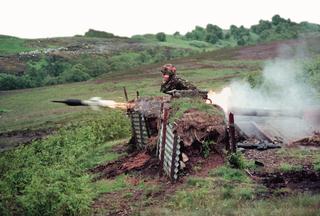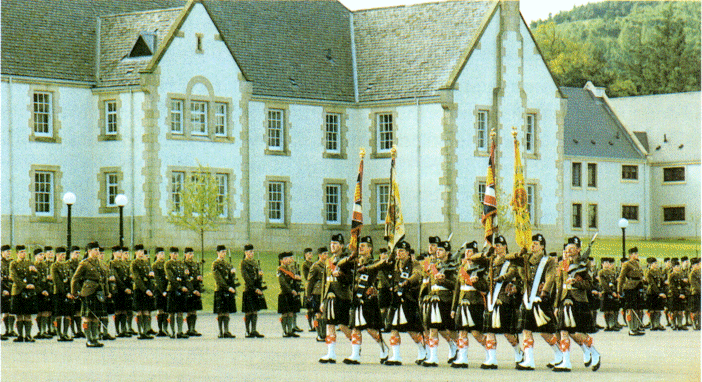The Seaforth, Gordons and Camerons.
Formed on 17 September 1994, The
Highlanders are proud descendants of five
famous Scottish Regiments raised in the late
18th Century.
The new regiment proudly carries on the traditions of its antecedent regiments who have won 366 battle honours over 200 years in campaigns worldwide. The traditions are reflected in the uniform. For example, the regimental cap badge, with its symbolic stag's head and gaelic motto Cuidich n' Righ (Save the King), is that worn previously by the Queen's Own Highlanders, with the royal blue hackle commemorating Queen Victoria's wish that the Camerons be designated her own regiment.
The tartan of each antecedent regiment forms part of The Highlander's dress; the kilt is Gordon, the trews Seaforth Mackenzie, and the pipers and drummers wear Cameron of Erracht tartan.
A number of different collar badges are worn. Officers wear the Sphinx of Egypt, where both Camerons and Gordons served with distinction in the early 19th century; the Indian Tiger is worn to commemorate the campaigns of Seringapatam and Mysore between 1799-1807, where the 75th Regiment fought against Tipoo Sahib's 'Tiger' Battalions. In Central India in 1803 the Seaforths were part of a force that defeated a much larger French-trained Maharrata force at the battle of Assaye, earning the right to wear the Elephant superscribed 'Assaye' as a collar badge.
HISTORY IN BATTLE
In 1815, both the 79th (Cameron) and 92nd (Gordon) Battalions played a central part in the famous victory at Waterloo. Piper Kenneth Mackay of the 79th courageously stepped outside the safety of the regimental square playing his pipes and inspired his regiment to repel continuous charges of French cavalry.
On the same day the 92nd charged against French infantry clutching the stirrup leathers of the Royal Scots Greys, screaming 'Scotland Forever'.
Six Victoria Crosses were won at Lucknow in 1857 where Seaforth Highlanders fought valiantly against the Indian Mutineers. 40 years later on the North West Frontier of India 1st Gordon Highlanders took the Heights of Dargai from Pathan tribesman. They charged across open ground under a withering hail of fire encouraged by Piper Findlater, who continued to play although shot through both ankles. His was one of two VC's won that day. The following year, in 1898, both Seaforth and Camerons formed part of Kitchener's force which defeated the Dervishes at the Battle of Atbara. All 3 regiments fought in the Boer War, earning 8 VC's between them and the battle honour South Africa 1899-1902.
20th CENTURY WARS
The sheer scale of the fighting in the World War I meant that each regiment was called on to expand rapidly. By 1918 the Seaforths had raised 19 battalions, the Gordons 21 and the Camerons 13. No fewer than 14 VC's were won, and close on 50,000 men lost their lives. The Second World War started disastrously with 5 battalions captured by the Germans at St Valery and one by the Japanese in Singapore. But from 1942 onwards each regiment fought with singular success from Alamein through North Africa, Sicily, Italy and from the Normandy Beaches to the Rhine. In the Far East too, fortunes changed and all battalions distinguished themselves in Burma. The regiment's 40th VC was won in 1944.

Highlanders anti tank section with Milan missile.

The Highlanders on Formation Day Parade 17th September, 1994.
Another site about the Highlandsrs may be found here.